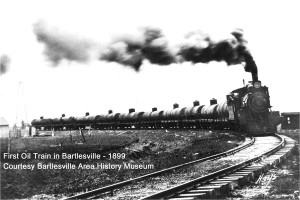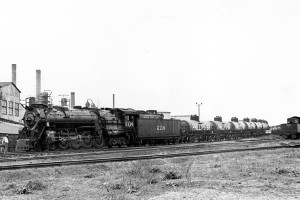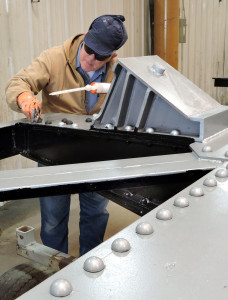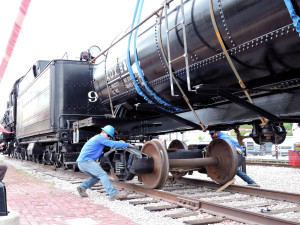Rolling Oil Cans
 Oil tank car AOX 930 was built in 1914 at the American Car and Foundry’s shop in Milton, PA. An all-riveted car, AOX 930 was constructed about a decade before welded tank cars became the norm.
Oil tank car AOX 930 was built in 1914 at the American Car and Foundry’s shop in Milton, PA. An all-riveted car, AOX 930 was constructed about a decade before welded tank cars became the norm.
With a capacity of 8,000 gallons, the car was assigned to the Associated Oil Company, which was formed by 34 independent oil producers in the Kern River field north of Bakersfield, CA. It was equipped with steam coil that heated the heavier crude oils from the Kern River field as well as heavy locomotive fuel oil moved in and out of Avon Refinery near San Francisco.
The Tank Gets Its Wings
 In 1925, the tank car was acquired by the holding company Tidewater Associated Oil Company, and the words “Tidewater” were added to the “Flying A” (Associated) logo on the car.
In 1925, the tank car was acquired by the holding company Tidewater Associated Oil Company, and the words “Tidewater” were added to the “Flying A” (Associated) logo on the car.
The oil tycoon J. Paul Getty, who coincidentally started his business career selling newspapers on the streets of Bartlesville, eventually gained control of Tidewater. The Flying A logo was known by the motoring public throughout the West because of the company’s numerous service stations that bore the distinctive identification mark.
Phillips Petroleum Rolls In
 Phillips Petroleum, headquartered in Bartlesville, purchased in 1966 Tidewater’s western refining, marketing and transportation assets, including the tank car fleet. The company immediately made preparations to incorporate the Tidewater cars into the Phillips fleet by providing them new numbers using the “PSPX” reporting mark assigned to Phillips in 1918.
Phillips Petroleum, headquartered in Bartlesville, purchased in 1966 Tidewater’s western refining, marketing and transportation assets, including the tank car fleet. The company immediately made preparations to incorporate the Tidewater cars into the Phillips fleet by providing them new numbers using the “PSPX” reporting mark assigned to Phillips in 1918.
Anti-trust problems forced Phillips to sell most of the former Tidewater assets in 1969, but it was allowed to retain the tank cars. AOX 930 was renumbered to PSPX 813 by painting out the “Gothic” Tidewater reporting marks – but not the “Tidewater” or “Flying A” logos, which were still visible when the tank ultimately arrived in Bartlesville more than 40 years later.
Detoured to Texas
 Apparently shortly after the car was renumbered to PSPX 813, the decision was made to sell it and other former Tidewater cars. PSPX 813 was sold to an individual in Laketon, TX, 50 miles SE of Borger. Upon arrival in Laketon, the car’s wheel sets and underframe were removed (and probably sold for scrap). The tank was placed on a concrete foundation and used to store animal oil for use in cattle feed production.
Apparently shortly after the car was renumbered to PSPX 813, the decision was made to sell it and other former Tidewater cars. PSPX 813 was sold to an individual in Laketon, TX, 50 miles SE of Borger. Upon arrival in Laketon, the car’s wheel sets and underframe were removed (and probably sold for scrap). The tank was placed on a concrete foundation and used to store animal oil for use in cattle feed production.
A volunteer with the Bartlesville Locomotive No. 940 Restoration Crew spotted the tank abandoned alongside a defunct cattle feed plant in March 2011. The tank was in excellent condition after nearly 100 years.
Putting It Together Again
 Following purchase negotiations with the owner, the 940 Crew arranged for the tank to be moved to Bartlesville by truck, where it was placed inside a secure facility for restoration. Wheel sets – or “trucks” – closely matching the originals were obtained from a railroad scrap yard in Texas, shipped to Bartlesville.
Following purchase negotiations with the owner, the 940 Crew arranged for the tank to be moved to Bartlesville by truck, where it was placed inside a secure facility for restoration. Wheel sets – or “trucks” – closely matching the originals were obtained from a railroad scrap yard in Texas, shipped to Bartlesville.
Members of the 940 restoration spent more than a year cleaning and repainting the tank, and restoring the original AOX 930 markings including the distinctive Flying A logo. Finally, DIW Engineering & Fabrication of Dewey, OK, was awarded the job of re-creating the missing underframe in a fashion nearly identical to the original. Making the underframe was complicated by the fact that the original was held together by rivets, a construction technique not used in rail car building since the 1930s, when welding became the norm. To reproduce the original look, volunteers used industrial adhesive to apply more than 500 simulated rivets made of ABS plastic. The results are very convincing!
Back on the Rails
 On the morning of April 23, 2015, the tank car — bearing the numbers of both its previous owners — returned to the rails. A six-member crew from Taylor Crane and Rigging of Coffeyville, KS, moved the tank, fastened to its “new” frame, to a final home between locomotive No. 940 and the Santa Fee caboose at the depot display track. In all, it took elements and parts gathered from six states to re-create the car plus hundreds of hours of volunteer time and ten of thousands of contributed dollars to put the sturdy rail car back on the tracks.
On the morning of April 23, 2015, the tank car — bearing the numbers of both its previous owners — returned to the rails. A six-member crew from Taylor Crane and Rigging of Coffeyville, KS, moved the tank, fastened to its “new” frame, to a final home between locomotive No. 940 and the Santa Fee caboose at the depot display track. In all, it took elements and parts gathered from six states to re-create the car plus hundreds of hours of volunteer time and ten of thousands of contributed dollars to put the sturdy rail car back on the tracks.